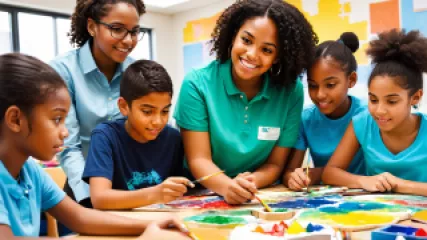Why Giftedness Coaching Options Are Essential for Nurturing Talent
Giftedness, a phenomenon often equated with exceptional intelligence or talent, remains one of the most misunderstood and underserved areas in education and mental health. While society glorifies high achievers, it frequently overlooks the unique challenges and needs that accompany giftedness. In my opinion, giftedness coaching options are not just beneficial but essential for nurturing talent.
Over the years, I've had the privilege to interact with numerous gifted individuals, and their experiences have painted a vivid picture of the complexities they face. These complexities make it clear that without proper guidance and support, many gifted individuals may never fully realize their potential. This is where giftedness coaching steps in as an indispensable tool.
The Paradox of Giftedness
At first glance, giftedness appears to be a blessing. However, beneath the surface lies a paradox. Gifted individuals often grapple with a range of emotional, social, and intellectual challenges that can hinder their development. The intensity and sensitivity that come with being gifted can lead to feelings of isolation and misunderstanding.
Consider the following:
- Intellectual Overexcitability: Gifted individuals often exhibit heightened intellectual curiosity and a deep need to explore complex ideas. This can make it difficult for them to relate to their peers.
- Emotional Overexcitability: Their heightened sensitivity can lead to intense emotional experiences, making them more susceptible to anxiety and depression.
- Social Challenges: Due to their advanced thinking and unique interests, gifted individuals may struggle to connect with others, leading to feelings of loneliness and social isolation.
Given these multifaceted challenges, it's evident that traditional educational and therapeutic approaches may fall short. This is where specialized giftedness coaching becomes crucial.
The Role of Giftedness Coaching
Giftedness coaching provides tailored support to help gifted individuals navigate their unique challenges and leverage their strengths. Unlike conventional therapy or counseling, which may not address the specific needs of gifted individuals, giftedness coaching offers a holistic approach. Here’s why it’s essential:
1. Personalized Guidance: Giftedness coaches understand the distinctive characteristics of gifted individuals and provide personalized strategies to help them thrive academically, emotionally, and socially.
2. Emotional Support: By acknowledging and validating the emotional experiences of gifted individuals, coaches can help them manage stress, anxiety, and other emotional challenges effectively.
3. Skill Development: Coaches work with gifted individuals to develop essential life skills, such as time management, goal setting, and resilience, which are crucial for long-term success.
4. Social Integration: Through coaching, gifted individuals can learn effective communication and social skills, enabling them to build meaningful relationships and overcome social isolation.
Online Therapy for Giftedness: A Modern Solution
In today's digital age, online therapy for giftedness has emerged as a convenient and accessible solution. Online platforms offer a range of resources and services tailored to the needs of gifted individuals. The benefits of online therapy include:
- Accessibility: Online therapy eliminates geographical barriers, making it easier for gifted individuals to access expert support regardless of their location.
- Flexibility: With online sessions, gifted individuals can schedule appointments at their convenience, accommodating their busy lives.
- Diverse Resources: Online platforms provide a wealth of giftedness therapy resources, including articles, videos, and interactive tools, enhancing the overall coaching experience.
The advent of online therapy has revolutionized the way giftedness coaching is delivered, making it more inclusive and effective. As someone who has witnessed the transformative impact of online therapy firsthand, I firmly believe that it holds immense potential for the future.
The Importance of Specialized Training for Coaches
Effective giftedness coaching requires specialized training. Coaches must possess a deep understanding of the nuances of giftedness and be equipped with the tools to address the unique needs of their clients. Key areas of training include:
- Understanding Giftedness: Coaches must be well-versed in the various types of giftedness, including intellectual, creative, and emotional giftedness.
- Psychological Insights: Knowledge of the psychological aspects of giftedness, such as overexcitabilities and asynchronous development, is crucial for effective coaching.
- Coaching Techniques: Coaches should be trained in evidence-based coaching techniques that are specifically designed for gifted individuals.
- Cultural Competence: Coaches must be sensitive to the cultural backgrounds of their clients and tailor their approach accordingly.
By investing in specialized training, we can ensure that giftedness coaches are well-prepared to provide the highest level of support to their clients. This, in turn, will contribute to a more inclusive and nurturing environment for gifted individuals.
The Impact of Early Intervention
Early intervention is a critical factor in the successful development of gifted individuals. Recognizing and addressing their unique needs at a young age can significantly enhance their academic, social, and emotional well-being. The benefits of early intervention include:
- Enhanced Academic Performance: Early identification of giftedness allows for appropriate educational accommodations, fostering a love for learning and academic excellence.
- Emotional Resilience: Early intervention helps gifted individuals develop coping strategies to manage their heightened emotions, reducing the risk of mental health issues.
- Positive Social Interactions: By teaching social skills and providing opportunities for peer interaction, early intervention promotes healthy social development.
To maximize the benefits of early intervention, it is essential to create awareness among parents, educators, and healthcare professionals about the importance of recognizing and supporting giftedness from an early age.
The Role of Parents and Educators
Parents and educators play a pivotal role in the development of gifted individuals. Their support and understanding can make a significant difference in nurturing the potential of gifted children. Here are some key ways in which parents and educators can contribute:
1. Recognize and Celebrate Giftedness: It is important for parents and educators to recognize giftedness and celebrate the unique talents and abilities of gifted individuals. This validation fosters a positive self-concept and encourages continued growth.
2. Provide Enrichment Opportunities: Offering enrichment activities, such as advanced coursework, extracurricular programs, and creative outlets, helps gifted individuals explore their interests and develop their talents.
3. Foster a Supportive Environment: Creating a supportive and inclusive environment at home and school allows gifted individuals to express themselves freely and seek help when needed.
4. Collaborate with Giftedness Coaches: Parents and educators can collaborate with giftedness coaches to develop personalized plans that address the specific needs of gifted individuals. This partnership ensures a comprehensive approach to their development.
The Future of Giftedness Coaching
As our understanding of giftedness continues to evolve, so too must our approach to coaching and support. The future of giftedness coaching holds exciting possibilities, including:
1. Integration of Technology: The use of technology, such as virtual reality and AI-driven tools, can enhance the coaching experience by providing immersive and interactive learning opportunities.
2. Collaborative Networks: Building collaborative networks of giftedness coaches, educators, and mental health professionals can facilitate the sharing of best practices and resources, leading to more effective support for gifted individuals.
3. Research and Innovation: Continued research into the unique needs and experiences of gifted individuals will drive innovation in coaching techniques and strategies, ensuring that support remains relevant and impactful.
By embracing these advancements, we can create a more inclusive and supportive environment for gifted individuals, empowering them to reach their full potential.
Conclusion
In conclusion, giftedness coaching options are essential for nurturing talent and addressing the unique challenges faced by gifted individuals. Through personalized guidance, emotional support, skill development, and social integration, giftedness coaching provides a holistic approach to fostering the potential of gifted individuals. The advent of online therapy for giftedness has further enhanced accessibility and convenience, making expert support available to a wider audience.
As we move forward, it is crucial to invest in specialized training for coaches, promote early intervention, and foster collaboration among parents, educators, and mental health professionals. By doing so, we can create a nurturing and inclusive environment that empowers gifted individuals to thrive and contribute meaningfully to society.
Ultimately, the importance of giftedness coaching cannot be overstated. It is a vital resource that not only supports the individual but also enriches the collective potential of our communities and society as a whole. Let us recognize and embrace the value of giftedness coaching options in nurturing the extraordinary talent that lies within each gifted individual.
Matt Adams is a passionate advocate for gifted education and mental health support. With years of experience working with gifted individuals, he believes in the transformative power of specialized coaching and therapy. His insights aim to inspire and inform those who seek to nurture the potential of gifted individuals.






